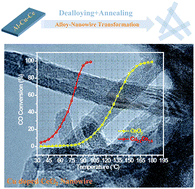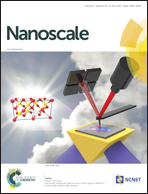Dealloying assisted high-yield growth of surfactant-free <110> highly active Cu-doped CeO2 nanowires for low-temperature CO oxidation†
Abstract
CeO2 is widely used as a commercial CO oxidation catalyst, but it suffers from high-temperature (>200 °C) complete conversion. Despite enormous efforts made to promote its low-temperature activity by interfacing CuO and CeO2, it is still a long-standing challenge to balance the desired catalytic activity with high-yield preparation. Creating intimate synergistic interfaces between Cu and Ce species and exploring surfactant-free large-scale methods are both critical and challenging. To address these concerns, we synthesized highly active Cu doped CeO2 nanowires for low-temperature CO oxidation, relying on intentionally maneuvering precursor alloy compositions and a high-yield dealloying method. The favorable one-dimensional doping structure inherited from the nanowire bundles of the as-dealloyed precursors, clean surfaces and intimate synergistic effects between Cu and Ce contribute to excellent CO oxidation performances, with 5% room-temperature conversion triggered at 35 °C and 100% conversion at 100 °C. 96% of O2 selectivity at 88 °C in CO preferential oxidation was also obtained. The long-term durability for 24 hours at 100% CO conversion without any decay confirms the robust characteristics of the catalysts. Moreover, this work offers some insights into the reasonable design of alloy precursors to realize property-oriented alloys to nanowires batch transformation for the study of industrial catalysts.



 Please wait while we load your content...
Please wait while we load your content...